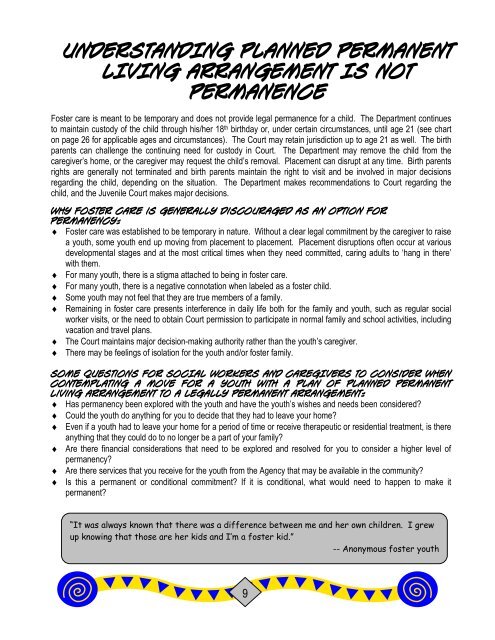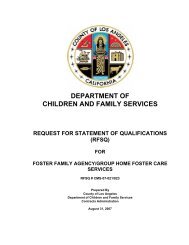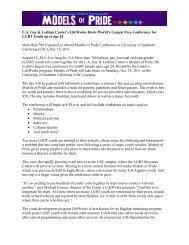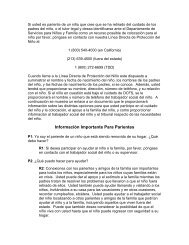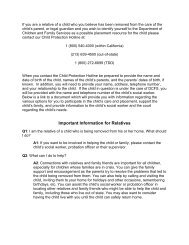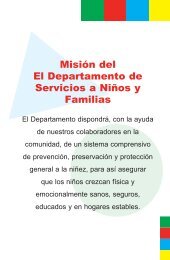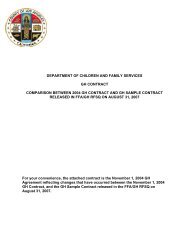Permanency Guide - Los Angeles County Department of Children ...
Permanency Guide - Los Angeles County Department of Children ...
Permanency Guide - Los Angeles County Department of Children ...
You also want an ePaper? Increase the reach of your titles
YUMPU automatically turns print PDFs into web optimized ePapers that Google loves.
UNDERSTANDING PLANNED PERMANENT<br />
LIVING ARRANGEMENT IS NOT<br />
PERMANENCE<br />
Foster care is meant to be temporary and does not provide legal permanence for a child. The <strong>Department</strong> continues<br />
to maintain custody <strong>of</strong> the child through his/her 18 th birthday or, under certain circumstances, until age 21 (see chart<br />
on page 26 for applicable ages and circumstances). The Court may retain jurisdiction up to age 21 as well. The birth<br />
parents can challenge the continuing need for custody in Court. The <strong>Department</strong> may remove the child from the<br />
caregiver’s home, or the caregiver may request the child’s removal. Placement can disrupt at any time. Birth parents<br />
rights are generally not terminated and birth parents maintain the right to visit and be involved in major decisions<br />
regarding the child, depending on the situation. The <strong>Department</strong> makes recommendations to Court regarding the<br />
child, and the Juvenile Court makes major decisions.<br />
Why Foster Care is Generally Discouraged as an Option for<br />
<strong>Permanency</strong>:<br />
♦ Foster care was established to be temporary in nature. Without a clear legal commitment by the caregiver to raise<br />
a youth, some youth end up moving from placement to placement. Placement disruptions <strong>of</strong>ten occur at various<br />
developmental stages and at the most critical times when they need committed, caring adults to ‘hang in there’<br />
with them.<br />
♦ For many youth, there is a stigma attached to being in foster care.<br />
♦ For many youth, there is a negative connotation when labeled as a foster child.<br />
♦ Some youth may not feel that they are true members <strong>of</strong> a family.<br />
♦ Remaining in foster care presents interference in daily life both for the family and youth, such as regular social<br />
worker visits, or the need to obtain Court permission to participate in normal family and school activities, including<br />
vacation and travel plans.<br />
♦ The Court maintains major decision-making authority rather than the youth’s caregiver.<br />
♦ There may be feelings <strong>of</strong> isolation for the youth and/or foster family.<br />
Some Questions FOR SOCIAL WORKERS AND CAREGIVERS to Consider When<br />
Contemplating a Move for a Youth with a Plan <strong>of</strong> Planned Permanent<br />
Living Arrangement to a Legally Permanent Arrangement:<br />
♦ Has permanency been explored with the youth and have the youth’s wishes and needs been considered?<br />
♦ Could the youth do anything for you to decide that they had to leave your home?<br />
♦ Even if a youth had to leave your home for a period <strong>of</strong> time or receive therapeutic or residential treatment, is there<br />
anything that they could do to no longer be a part <strong>of</strong> your family?<br />
♦ Are there financial considerations that need to be explored and resolved for you to consider a higher level <strong>of</strong><br />
permanency?<br />
♦ Are there services that you receive for the youth from the Agency that may be available in the community?<br />
♦ Is this a permanent or conditional commitment? If it is conditional, what would need to happen to make it<br />
permanent?<br />
“It was always known that there was a difference between me and her own children. I grew<br />
up knowing that those are her kids and I’m a foster kid.”<br />
-- Anonymous foster youth<br />
9


